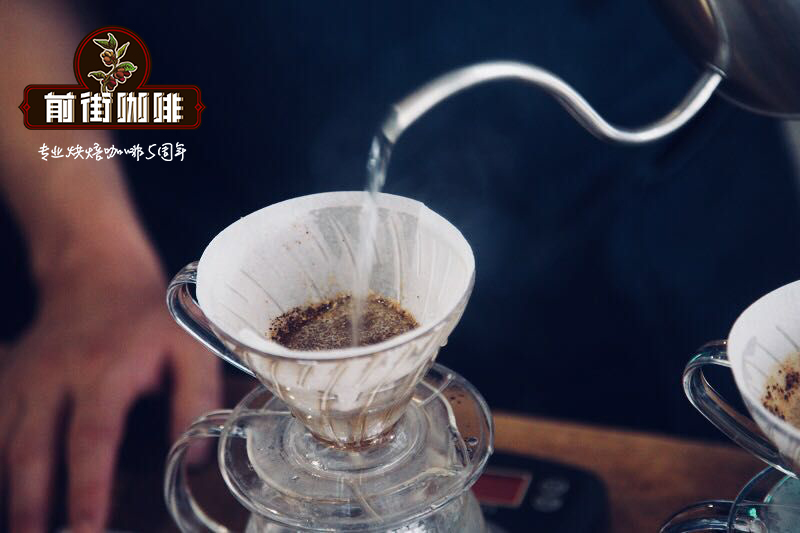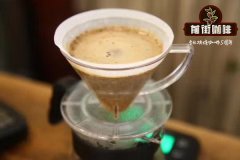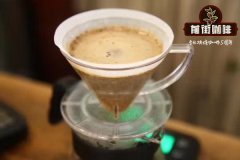Is Arabica bean caffeine high? How to make Arabica coffee beans? Arabica coffee

Professional coffee knowledge exchange more coffee bean information please follow the coffee workshop (Wechat official account cafe_style)
Is Arabica bean caffeine high? How to make Arabica coffee beans? What is the flavor and taste of Arabica coffee?
Arabica: expensive, supple taste, low caffeine
Coffee advertisements often emphasize that they use 100% Arabica coffee. Yes, in terms of price alone, Arabica is indeed more advanced, the average price of Arabica coffee beans is twice that of Robusta.
In terms of composition, Arabica coffee contains low caffeine (0.9-1.2%), 60% more fat and twice as much sugar, so taken together, Arabica coffee tastes sweet, soft and sour like plums.
In addition, Arabica coffee has lower chlorogenic acid (5.5-8%), and chlorogenic acid is not only an antioxidant, but also an important component of resistance to pests, so Arabica coffee is more vulnerable to insects and climate. Generally planted at higher elevations, the fruit is less and slower. The fruit is oval.
Arabica coffee is generally thought to be native to the Abyssinia Plateau of Ethiopia and widely distributed in the tropics. Many varieties have been derived from repeated mutations or mating. Now, it is said that there are more than 70 varieties of Arabica coffee alone.
The so-called "planting" rice is the difference between the long rice of Induca and the short rice of Japonica, that is, the difference between Thai rice and Japanese rice. This may be easier to understand. Then look at the 'subspecies, varieties, varieties' derived from the 'species'; the variety here refers to Yueguang rice. There are many kinds of coffee, just like rice.
Of course, in terms of variety improvement, coffee is the same as rice, which constantly seeks to improve disease resistance, production and environmental adaptability. in addition, rice also pursues variety improvement in taste. On the contrary, coffee not only pays less attention to this point, but also has the suspicion of 'changing evil'. In order to pursue production efficiency, the improvement of the quality of coffee taste has become a secondary consideration.
This tendency can be seen from the recent trends in the world coffee market. The market has paid more attention to high-quality coffee, that is, high-quality coffee, and coffee producers and consumers are eager to introduce new evaluation criteria. Coffee is highly rated and can be bought and sold at a high price, most of which are inherent varieties of Arabica species (or 'old trees'), such as Tibica, bourbon, Kaddura (mutants of bourbon), etc.
Among the varieties produced today, the traditional varieties have the lowest yield and disease resistance, but their rich flavor is irreplaceable.
I am by no means a believer in Tibica or bourbon coffee, nor am I a variety supremacist, but there is no denying that variety is an important factor in the taste of coffee, and more and more people are paying attention to it.
I would like to introduce the varieties and characteristics of Arabica coffee.
Tibica (Typica)
This is the closest variety of Arabica species to the original species, and almost all Arabica species originated here. Used to be widely cultivated in Central and South America, the bean shape is long and has excellent aroma and sour taste, but it is not resistant to leaf rust and requires a considerable number of shading trees, resulting in low production (the same as Bourbon, which can only be harvested every two years). Originally, all varieties of Tibica were grown in Colombia until 1967, but now 80-90% of them have switched to Kaddura (Caturrra), which is highly productive and resistant to direct sunlight, or a variety of Colombia (Variedad Colombia). At present, there are very few pure Tibica on the Colombian market.
Bourbon (Bourbon)
Tibica is the best secondary species closest to the original species of Arabica, while bourbon is the second species caused by Tibica mutation. These two are the oldest varieties of coffee in existence. Bourbon was transplanted from Yemen to the eastern part of Madagascar in East Africa, to the island of Bourbon in the Indian Ocean (now known as Reunion), and then to Brazil with the French colonists. It is characterized by small and round beans, mostly dense and gregarious, so the central line is S-shaped.
The harvest is 20-30% more than Tibica, but it is still too small compared with other high-yield varieties, and it is only harvested once every two years, so it is gradually replaced by other varieties. The mating species and mutants of bourbon, such as Mundo Novo and Catuai, are of high quality in aroma and alcohol thickness, and all have the characteristics of Tibica.
Kaddura (Caturra)
This is a bourbon mutant found in Brazil; the height of the tree is low, the bean has small grains, high yield and resistance to leaf rust. The disadvantage is that it only bears fruit every other year, that is, it can only be harvested once every two years. Although the quality is very high, the cost of care and fertilization is quite high. It is suitable for cultivation in the mid-highlands with an altitude of 450-1700 meters and an annual rainfall of 2500-3500 mm. It is characterized by sour taste and slightly stronger astringency.
Mondo Norwood (Mundo Novo)
Natural mating between bourbon species and Sumatra species found in Brazil. It is highly adaptable to the environment and resistant to diseases and insect pests. Although it belongs to a high-yield variety, its growth rate is slow and the bean grain is too large. The tree height of more than three meters is its disadvantage (this height has exceeded the height that the harvester can reach, so it is not suitable for planting in areas where coffee harvesting is mechanized), the top branches and leaves of coffee trees should be trimmed every year. It began to be planted in the whole region of Brazil around 1950 and is now the main variety in Brazil along with Kaddura and Catuai. Mondonovo had a good balance of sour and bitter taste, and his taste was close to the original variety, so the first question of the city was widely expected, and it was named 'Mundo Novo (meaning New World)'.
Kaduai (Catuai)
The mating species of Mundo Novo and Caturra. The yield is high and the environment is adaptable, and the tree is high and high (because the tree of Montanovu is too high, it is difficult to harvest, so it is mated with Kaddura of tree height). Unlike Kaddura, Kaddura bears fruit year after year. Although it must be fully fertilized, it is resistant to diseases and insect pests, and the fruit is not easy to fall in the face of strong wind and rain. Only the fruit growth and harvest life is only about ten years, the life span is too short is its weakness. It is mainly cultivated in the vast area from Colombia to Central America. The taste of Kaduai is more monotonous and less mellow than Montanovo.
Marago Gippe (Maragogype)
This is the Tibica mutant found in Brazil. Beans are large and need to be filtered with a sieve of more than 19 sizes. The taste is poor and the appearance is good, so it is favored by some markets. The height of the tree is high, so the yield is low.
Kent (Kent)
Indian breed. It has high yield and strong resistance to diseases, especially leaf rust. It is thought to be a hybrid of Tibica and other varieties.
Amaret O (Amareiio)
Generally speaking, the fruit of coffee appears red when it is ripe, but the fruit of this variety is just like its name (Amareiio comes from the modern Latin word Amareiius-, which means "yellow"), and the fruit is yellow when ripe. The yield is high because of the height of the tree.
Cartimo (Catimor)
Born in Portugal in 1959, the strong leaf rust species Timor (the mating of Arabica and Robusta) was mated with bourbon mutant Kaddura. Among the commercial varieties with high yield, it has the best growth length and the highest yield. The height of the tree is low, and the fruits and seeds of coffee (raw beans) are on the large side. There are quite a number of new varieties derived from Cartimo. Generally speaking, the varieties of the Cartimo series are strong, adaptable to the environment and high in yield. Only in terms of taste, the low-real estate Katimo is not far different from other commercial varieties, but the Katimo produced in the highlands above 1200 meters above sea level is obviously at a disadvantage compared with Bourbon, Kaddura, Kaduai, and so on.
Mutant Columbia (Variedad Colombia)
A variety with high disease resistance produced by mating between Cartimo and Kaddura. Resistant to direct sunlight, and can be harvested in a short time. Colombia began to grow widely in the 1980s, replacing the previous inherent variety Tibica as the main variety. Generally speaking, Arakabi coffee trees, represented by Tibica, must have shade trees for it, but the mutant Colombian coffee trees with 1/4 Robusta pedigree do not need shelter trees and can be produced and harvested throughout the year. It is just that in recent years, coffee beans may emit Phenol, which is similar to the smell of iodine, due to the influence of pesticides or chemical fertilizers. The difference with the inherent variety Tibica can be seen at a glance through Deep City Bakery (Full-city roasting). Generally speaking, the sour taste of coffee becomes weaker and the bitter taste increases after roasting in deep cities, while the bitterness of the mutant Colombian coffee increases sharply after the second burst period.
Hand punching mode: filter paper dripping type
Using filter paper to brew coffee is a convenient, simple and hygienic way. To brew a cup of drip coffee in the easiest way, you only need to prepare a filter (sold in many cafes). It is divided into heat-resistant plastic, ceramic and metal materials, which can be bought according to your personal preference. Then you just take a normally used mug, put the filter on the cup, and cover it with filter paper. Then pour in the ground coffee powder, prepare a pot of hot water, and you can brew a cup of delicious, hot fresh coffee at home.
The dripping brewing method of filter paper is mainly to fully mix the coffee powder with hot water, extract four flavors and one fragrance from the coffee, and then leak out through the filter paper. this way can filter the fat, protein and bad impurities in the coffee, get the coffee with a refreshing taste, and take care of your health while enjoying the delicious food.
When you brew yourself for the first time, you can easily enjoy a good taste at home as long as you pay attention to the following.
(1). Beans: only good beans have good coffee. Choose beans that suit your taste, buy them in small quantities depending on the amount used, and store them in an airtight container to maintain their freshness and charming aroma. Of course, if you have more budget, it is absolutely worthwhile to invest in a good bean grinder. Freshly ground coffee powder can provide fragrance in the air and delicacy from brewing, making your investment absolutely worthwhile.
(2). Water flow: the biggest technique for brewing brewed coffee is to control the thickness and stability of the water flow.
The steady and moderate flow spirals outward from the central point of the filter, just like a stirring stick evenly stirring the coffee powder and hot water, releasing all the concentrated alcohol sweetly. If you are already obsessed with the method of brewing coffee, you might as well buy a beautiful brewing pot at this time. Its biggest feature is its slender and long outlet pipe, which allows people who have never used it to pour out fine and stable water easily. Help you instantly have the brewing level of a professional coffee hand, not to mention the delicacy of this cup of coffee.
(3). Warm cup: also remind all coffee lovers that hot coffee must be drunk while it is hot, it is the most delicious time for coffee.
The action of warming the cup can prolong the heat of the coffee, as long as the hot water is injected into the coffee cup, the cup is warm by the temperature of the hot water, and then the hot coffee is poured out and then injected with the hot coffee that has just been brewed, which can help maintain the heat of the coffee and prolong the time to enjoy delicious coffee.
Friends who want to make their own brewed coffee at home, do it now! You will find that the process is so simple and full of fun, enjoy your DIY's delicious coffee in the strong aroma of coffee, and the leisurely holiday afternoon becomes poetic and picturesque.
Important Notice :
前街咖啡 FrontStreet Coffee has moved to new addredd:
FrontStreet Coffee Address: 315,Donghua East Road,GuangZhou
Tel:020 38364473
- Prev

Arabica coffee beans characteristics and flavor taste? What is the difference between Arabica and Robusta coffee beans?
Professional coffee knowledge exchange More coffee bean information Please pay attention to coffee workshop (Weixin Official Accounts cafe_style) Arabica coffee beans characteristics and taste? What is the difference between Arabica and Robusta coffee beans? High caffeine? Arabica: expensive, soft, coffee
- Next

The mocha pot of coffee? Do you want mocha coffee to be made in a mocha pot? Hot mocha coffee with milk
Professional coffee knowledge exchange more coffee bean information please follow the coffee workshop (Wechat official account cafe_style) mocha pot coffee practice? Do you want mocha coffee to be made in a mocha pot? Would you like your hot mocha coffee with cream? What are the practices and techniques of mocha pot coffee? Using the vapor pressure of boiling hot water to extract coffee close to the flavor of espresso, it is straight from Italy.
Related
- Detailed explanation of Jadeite planting Land in Panamanian Jadeite Manor introduction to the grading system of Jadeite competitive bidding, Red bid, Green bid and Rose Summer
- Story of Coffee planting in Brenka region of Costa Rica Stonehenge Manor anaerobic heavy honey treatment of flavor mouth
- What's on the barrel of Blue Mountain Coffee beans?
- Can American coffee also pull flowers? How to use hot American style to pull out a good-looking pattern?
- Can you make a cold extract with coffee beans? What is the right proportion for cold-extracted coffee formula?
- Indonesian PWN Gold Mandrine Coffee Origin Features Flavor How to Chong? Mandolin coffee is American.
- A brief introduction to the flavor characteristics of Brazilian yellow bourbon coffee beans
- What is the effect of different water quality on the flavor of cold-extracted coffee? What kind of water is best for brewing coffee?
- Why do you think of Rose Summer whenever you mention Panamanian coffee?
- Introduction to the characteristics of authentic blue mountain coffee bean producing areas? What is the CIB Coffee Authority in Jamaica?

